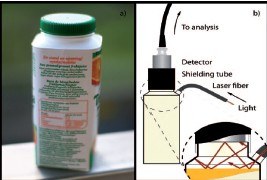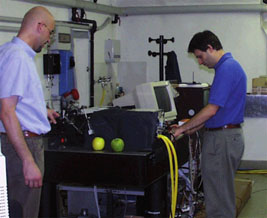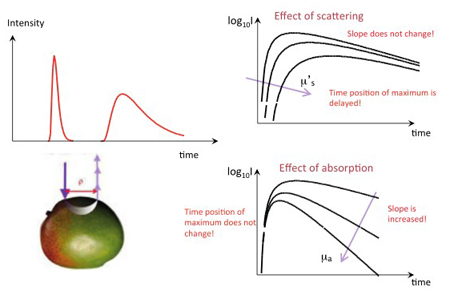Food
- Checking the quality of packaged food – from the outside!
- Non-destructive assessment of internal fruit quality by time-resolved reflectance spectroscopy
Checking the quality of packaged food – from the outside! | Lund Laser Centre
 |
|
|---|---|
|
Packaged food quality monitoring by laser |
A laser-based, non-intrusive measurement technique developed at Lund Laser Centre could lead to better quality assurance and less waste of chilled packaged foods. The popularity of fresh, chilled foods – such as packaged fruit juices – is increasing by the day. In order to slow down deterioration processes and prolong shelf life, traditional packaging methods are being replaced by modified atmosphere packaging: the headspace of the packages are filled with, e.g., nitrogen gas, while the presence of oxygen – which assists in chemical breakdown and microbiological spoilage of the food – is reduced to the minimum.
As expiration dates are based on conservative estimates, huge quantities of chilled foods are thrown away daily while the quality might still be up to standard – whereas food that has, e.g., been stored at too high temperatures will still be spoiled before the expiration date. If modified atmosphere is applied, the life time will also depend on the level to which the composition of the head space gas is maintained. Small leaks will lead to an increase in the oxygen content inside the package and thus to a reduced life time. Lack of information on the storage temperature history and headspace gas composition may lead to quality and safety issues. Over the years, many sensing techniques have been developed to check the quality of packaged foods, but almost all of them are intrusive – the package is destroyed and the food is wasted.
Researchers at Lund Laser Centre now have developed a novel, non-intrusive method to measure the oxygen content of the package headspace, called 'gas in scattering media absorption spectroscopy' (GASMAS). In GASMAS, infrared light from a diode laser is sent onto the food package. A small part of the light penetrates into the package, and an even smaller amount of light emerges from it and is detected by a sensitive detector. From the amount of light absorbed inside the package, the oxygen concentration in the headspace can be determined. The Lund researchers believe the GASMAS technique (which has also been demonstrated to be effective in measurements of the lung content of newborn infants and the gas composition in sinuses of adult patients) could be used for 'inline' quality control of packed food items throughout the food packaging supply chain.
Reference: M. Lewander et al., Packaging Technology and Science, 24: 271-280 (2011)
Non-destructive assessment of internal fruit quality by time-resolved reflectance spectroscopy | Cusbo, Milano
 |
|---|
| The laboratory TRS system available at CUSBO |
With near-infrared light, the internal state of food can be probed in a non-destructive way. Consequently, near-infrared spectroscopy (NIRS) can be used to enhance the quality of the food we eat. A relatively new laser-based technique, called time-resolved reflectance spectroscopy (TRS), has several advantages over the traditional NIRS techniques using lamps or LEDs. Since 2003, the Center for Ultrafast Science and Biomedical Optics (CUSBO) at Politecnico di Milano (Milan, Italy) has been offering Transnational Access to a unique TRS system for non- destructive measurements on food. Alessandro Torricelli from CUSBO explains.
Food, like most biological materials, is opaque to near infra-red (NIR) radiation due to the complex interplay be- tween light absorption and light scattering. Absorption and scattering are related to tissue composition (e.g., com- pounds with specific absorption bands, like water, sugars, chlorophylls, and carotenoids) and tissue structure (e.g., size and density of cells, intra- and extra-cellular environ- ment), respectively. Absorption is relatively low in the NIR range. Therefore, light can penetrate deeply into biologi- cal tissue. Conversely, scattering is remarkably larger and this allows for NIR light radiation to diffuse in the sample volume and to be reemitted at tissue boundaries. Non- destructive monitoring of food quality by near infrared spectroscopy (NIRS) has rapidly evolved from the labora- tory stage to industrial applications.
The common approach to NIRS is the continuous wave (CW) technique, where steady state light sources (e.g., lamps or LEDs with constant intensity in time) and photo- detectors (e.g., photodiodes or CCD cameras) are used to measure light attenuation. The absorption characteristics of the sample are then derived by the Lambert-Beer Law. Indeed, light scattering can significantly affect light at- tenuation, resulting in a need for calibration for each new batch of samples. To tackle this effect, a modified version of the Lambert-Beer Law has been introduced, but results are far from optimal.
In the last decade, the study of light propagation in diffusive media has been fostered by potential diagnos- tic and therapeutic applications in the biomedical field. Physical models for light diffusion based on an approxi- mate solution of the Radiative Transfer Equation have been proposed, allowing for an accurate description of the contributions from light absorption and light scat- tering. These models consider light as a stream of pho- tons instead of an electromagnetic wave and the physical framework is often referred to as photon migration. The absorption coefficient and the reduced scattering coef- ficient are introduced, assuming a given probability for photons to be absorbed or scattered per unit length. For photons traveling inside the medium, the energy balance is used to derive the photon density (i.e., the number of photons per unit volume and time) and the photon prob- ability of being remitted at sample boundaries (i.e., dif- fuse reflectance).
In addition, advanced techniques have been proposed to improve the classical CW approach to NIRS, in particular time domain and space-resolved NIRS. The main feature of time-resolved reflectance spectroscopy (TRS) is its ability to retrieve information on photon path-length in a diffu- sive medium. Photon path-length is influenced by scatter- ing and absorption events and it is generally much larger than the geometrical distance between source and detec- tor, typically on the order of a few meters. TRS measures the distribution of photon time-of-flight (related to pho- ton path length by the speed of light in the medium) at the picosecond or nanosecond time scale at a fixed sourcedetector distance (e.g., 15 mm) by means of pulsed laser sources (with duration of tens of picoseconds) and fast detection techniques (e.g., time correlated single photon counting) (Torricelli et al., 2008).
The use of TRS in combination with proper physical models for photon migration allows for complete opti- cal characterisation, using simultaneous non-destructive measurements of the optical properties (absorption and scattering) of a diffusive medium. This can be of special interest for most fruits and vegetables, as well as for other foods (e.g. meat, fish, and cheese), because information derived by TRS refers to the internal properties of the me- dium, and is not so much affected by surface features as is the case for CW NIRS. Moreover, from the optical param- eters information can be obtained on the physical proper- ties, such as the density (or number) and size of particles or droplets (in case of emulsions). Those parameters are im- portant for the processing of food (e.g., cheese, milk, juice, and puree) and subsequently for the quality of the derived food products.
TRS is totally non-invasive since the optical radiation in the 600-2000 nm spectral range (red and near infrared) is non-ionising. Moreover, very limited power (average power of a few mW) is typically employed in TRS systems. Therefore no chemical, mechanical or thermal damage can occur to the sample. TRS has the capacity to probe in- ternal microstructural properties with minimal influence from the optical properties of the surface. Moreover, in case of anisotropic samples, suitable models are available to interpret diffuse reflectance data, e.g., fruits like melon with a thick skin can be modelled as layered media and the optical properties of upper and lower layers can be evaluated.
 |
|---|
| Scheme of the method used for non-destructive measurements on food |
Within the framework of LASERLAB-EUROPE, CUSBO has been offering access to a unique TRS system for non- destructive measurements on food since 2003. The system is a broadband fully automated TRS spectrometer devel- oped by PoliMi during the research project DIFFRUIT. Poli- Mi is also equipped with a portable TRS system, which can be used to perform measurements at harvest close to the orchards.
The first collaboration with experts in the food sec- tor originated by a personal invitation to Prof. Bart Nico- lai (MeBioS, KU Leuven, Belgium) and a TRS measurement campaign on pear was performed, also in comparison to CW NIRS (Nicolai et al., 2008). The following collaborations were initiated by the contacts provided by Dr. Paola Eccher Zerbini (CRA-IAA, Milan, Italy). CUSBO and CRA-IAA are closely located and actively collaborating in national and international projects. In many cases, users took advan- tage of the possibility to properly store fruit in controlled atmosphere rooms and to make classical destructive (e.g., firmness, brix, dry mass) and non-destructive (e.g., weight, skin colour) measurements at CRA-IAA facilities.
Dr. Eivind Vangdal (Planteforsk, Norway), for example, performed TRS measurements at CUSBO for maturity as- sessment and detection of defects in plums (Vangdal et al., 2010), whereas Dr. Pol Tijskens (HCP-WUR, Wageningen, The Netherlands) applied biological shift models to TRS data for maturity assessment in nectarines and mango (Tijskens et al., 2007). Susan Lurie (ARO, Israel) studied internal disorders in peaches and their detection by TRS (Lurie et al., 2012). On the other hand, Dr. Manuela Zude (ATB, Potsdam, Germany) gained access to the CUSBO TRS facility for the calibration of CW NIRS sensors by directly contacting LASERLAB-EUROPE (Zude et al., 2008).
For all access projects, the specific expertise from the various partners (e.g., postharvest, biological modelling) and from the group at the laser facility (e.g., light propa- gation in diffusive media, advanced technique for photon detection at the picosecond scale) contributed to the suc- cess of the experiments and to the opening of further col- laborations. Several research projects in fact stem from LASERLAB-EUROPE collaborations: InsideFood (coordinated by Prof. Nicolai), 3D Mosaic (coordinated by Dr. Zude, ATB Potsdam) and TROPICO (coordinated by undersigned, with WUR Wageningen as partner).

